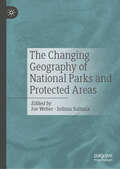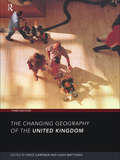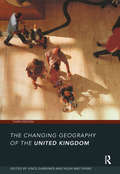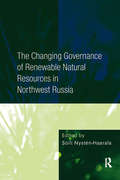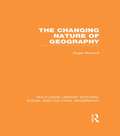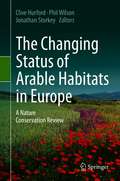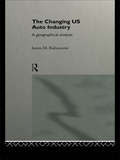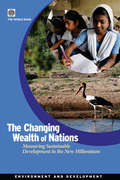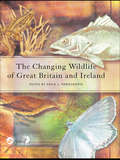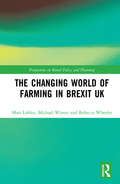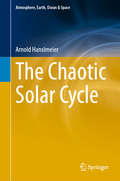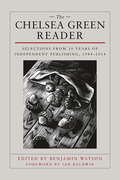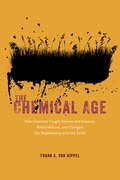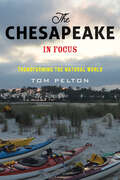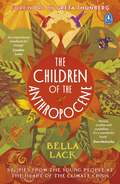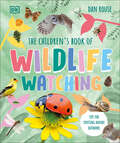- Table View
- List View
The Changing Geography of National Parks and Protected Areas
by Joe Weber Selima SultanaThis book contains recent geographic work examining the changing geography of protected areas in the U.S. and Europe. These places can be national parks, forests, or other places that are being protected for their significant aesthetic, historical, or environmental values by governments and communities. These places can be studied with reference to their physical environments, the management of their plant and animal life, which places are to be protected, who visits these places (and who does not, and why not), and how we think of these places. This work includes examinations of many parks and issues that affect them, such as land degradation, the social and political geography involved in creating new national park units, visitation by underserved segments of the population, and the changing names of protected areas. It makes use of work using methods and data as diverse as remote sensing, nineteenth survey plats and GIS, and online visitor surveys.
The Changing Geography of the UK
by Hugh Matthews Vince GardinerFirst published in 2000. Routledge is an imprint of Taylor & Francis, an informa company.
The Changing Geography of the UK 3rd Edition
by Vince Gardiner; Hugh MatthewsThis book presents a full description and interpretation of the changes that have occurred in the United Kingdom during the 1990s. It offers an understanding of the social, economic, political, and physical forces bringing about the changes in the United Kingdom.
The Changing Governance of Renewable Natural Resources in Northwest Russia
by Soili Nysten-HaaralaBringing together scholars of human geography, environmental sociology, law, economics and international policy from Finland, Russia, Sweden and Germany, this book examines how local communities and enterprises adjust to transition and institutional changes in Northwest Russia. A unique and important facet of the book is that it analyzes the law and legal institutions, focusing on how those involved in law use or abuse it, in relation to unofficial institutions and the interplay of different interest groups in governing forest and fishery resources. The local view is approached empirically with data gathered through interviews, which is then compared against institutional change at national level and in the global arena. Multidisciplinary in nature, the book demonstrates innovative ways of adjusting to change, combining old and new, local and global and providing a holistic view of the Russian economy and a society in transition.
The Changing Land: Module F
by Leonard Bernstein Martin Schachter Alan Winkler Stanley WolfeIn this book, you will use a variety of science process skills to understand the facts and theories in earth science.
The Changing Nature of Geography (Routledge Library Editions: Social and Cultural Geography)
by Roger MinshullThis book is an introduction to the nature of geography. There are detailed sections on content, methods and purposes and an attempt is made to distinguish progress from those changes which are merely fashion and those which result in genuine progress. One of these, resulting partly from the adoption of quantitative techniques, is the improvement in the accuracy and the type of explanation which the geographer is now able to give. The new techniques have also helped in the bringing about of profound changes in geographical laws, the use of models and even the relevance of determinism.
The Changing Profile of Corporate Climate Change Risk (Doshorts Ser.)
by Mark Trexler Laura KosloffThis book will help business executives to (1) rethink their perceptions of climate risk (2) evaluate whether their company is effectively positioned, and (3) make informed and prudent business decisions about climate change risk in an environment rife with policy uncertainty.Business risk associated with climate change is commonly assumed to be primarily policy driven. Many companies internalize the current stalemate over global climate policy into a perception that climate risk is no longer a critical issue. Business climate risks, however, include: Operational and Supply Chain (Physical) Risk, Brand Risk, Market-driven Structural Risk, Liability Risk.As national and global policy to materially reduce climate change is delayed, it is business-prudent to assume that the level of climate risk is increasing. Even if policy risk might seem lower today than a few years ago, political will can change quickly. Should physical impacts of climate change manifest in dramatic ways, for example, draconian climate policy is likely to follow quickly. These conditions create a complex and shifting business risk environment, and most companies either overlook or substantially underestimate key climate risks. How many companies, for example, are positioned for material climate change outcomes, whether physical or regulatory? Companies with little climate change exposure may not face much downside risk from taking a wait-and-see approach. For those with greater exposure, being "too late" to respond will mean costs and competitive impacts that could have been avoided. Being "too early," however, can mean being penalized later for actions that reduce a company’s emissions today, or competitive disadvantage from getting too far out in front of competitors.
The Changing Status of Arable Habitats in Europe: A Nature Conservation Review
by Clive Hurford Phil Wilson Jonathan StorkeyThis edited volume documents the current nature conservation status of arable habitats in Europe. Arable farming systems have evolved in the European landscape over more than ten thousand years and now occupy nearly 30% of the European land area. They support species that have life cycles closely synchronised with traditional cereal growing, many of which have experienced massive declines throughout Europe. For example, in Britain, of the 100 plant species exhibiting the greatest declines in the latter half of the 20th century, 47 were typical of arable land. Despite this the habitat and many of the species associated with it remains unprotected across much of Europe. The 22 chapters cover a range of topics, including: · Regional accounts describing the impact of changing agricultural practices on the arable flora;· The results of research and surveillance projects on the soil organisms, bryophyte flora, invertebrate fauna and pollinators of arable habitats;· The potential for designing multifunctional and resilient agricultural landscapes; The use of ex situ conservation to aid the reintroduction of rare arable plants;· Case studies illustrating how changing agricultural practices have impacted on bird populations in Europe; · The roles of remote sensing in monitoring agricultural systems; · How agri-environment schemes can help restore the biodiversity in arable habitats; and · A look forward at ways to help ensure the future security of the species associated with arable habitats. It is clear that the biodiversity of arable land throughout Europe has undergone major changes, particularly during the second half of the 20th century, and that these changes are continuing into the 21st century. We need to develop a deeper appreciation of farmland wildlife and its integration into farming systems to ensure its future security in a world where value is increasingly expressed in terms of material profit. This book is particularly relevant to practitioners, policy-makers and managers working in the fields of nature conservation, agri-environment schemes and land management, and to researchers working in the fields of conservation biology, terrestrial ecology, nature conservation, applied ecology, biodiversity, agriculture, agricultural ethics and environmental studies.
The Changing U.S. Auto Industry: A Geographical Analysis
by James M. RubensteinFirst published in 1992. Routledge is an imprint of Taylor & Francis, an informa company.
The Changing Wealth of Nations: Measuring Sustainable Development in the New Millennium
by World BankThis book is the latest report by the World Bank to estimate comprehensive wealth -- including produced, natural and human / institutional assets -- for over 100 countries. This ground-breaking report presents wealth accounts for 1995, 2000, and 2005, permitting the first longer-term assessment of global, regional, and country performance in building wealth. This overall assessment is complemented by chapters detailing individual components of wealth, as well as how countries and the World Bank are using comprehensive measures of wealth for policy analysis.
The Changing Wildlife of Great Britain and Ireland (Systematics Association Special Volumes Ser.)
by David L. HawksworthPeriodic comprehensive overviews of the status of the diverse organisms that make up wildlife are essential to determining trends, threats and future prospects. Just over 25 years ago, leading authorities on different kinds of wildlife came together to prepare an assessment of their status of a wide range of organisms in Great Britain and Ireland i
The Changing World of Farming in Brexit UK (Perspectives on Rural Policy and Planning)
by Michael Winter Matt Lobley Rebecca WheelerThe 2016 referendum resulted in a vote for the United Kingdom to withdraw from the European Union. This has led to frenzied political debate across the whole spectrum of policy, and agriculture is no exception. For the first time in a generation, the future of agriculture is unclear and unfettered by the constraints and incrementalism of the Common Agricultural Policy. This book makes an empirical contribution to the Brexit debate, bringing a social dimension to agri-Brexit and sustainable agriculture discourses. Understanding the social in the context of farmers is vital to developing a way forward on food security and agricultural sustainability. Farmers are the recipients of the market and policy signals that link to global uncertainties and challenges. This book is a commitment to understanding farmers as occupiers and managers of land. Chapters in this book explore farmers’ own aspirations and knowledge about patterns of land use and production, which underpin discussions around the environment and sustainability. There is a deficit in understanding what kind of agricultural industry we now have, following years of restructuring and repositioning. This book is an attempt to address that deficit and will appeal to students and researchers exploring agriculture, food politics and rural sociology.
The Chaotic Solar Cycle (Atmosphere, Earth, Ocean & Space)
by Arnold HanslmeierThis book offers an overview of solar physics with a focus on solar activity, particularly the activity cycle. It is known that solar activity varies periodically, but there are also phases of intermittency, such as the Maunder minimum, during which solar activity is very low or high over several decades. The book provides a brief introduction to chaos theory and investigates solar activity in terms of its chaotic behavior. It also discusses how intermittent phases of solar activity have affected and can affect Earth’s climate and long-term space weather, and reviews the underlying theories relating to the solar dynamo mechanism. Furthermore, each chapter includes references to scientific literature (review articles and papers) so that readers can delve deeper into the subjects covered. This richly illustrated book will appeal to a wide readership, and is also useful as a textbook for courses in solar physics and astrophysics.
The Chelsea Green Reader: Selections from 30 Years of Independent Publishing, 1984-2014
by Edited by Ben WatsonChelsea Green, the Vermont-based independent publisher, has always had a nose for authors and subjects that are way ahead of the cultural curve, as is evident in this new anthology celebrating the company’s first thirty years in publishing.The more than one hundred books represented in this collection reflect the many distinct areas in which we have published–from literature and memoirs to progressive politics, to highly practical books on green building, organic gardening and farming, food and health, and related subjects–all of which reflect our underlying philosophy: "The politics and practice of sustainable living." The Chelsea Green Reader offers a glimpse into our wide-ranging list of books and authors and to the important ideas that they express. Interesting and worth reading in their own right, the individual passages when taken as a whole trace the evolution of a highly successful small publisher–something that is almost an oxymoron in these days of corporate buyouts and multinational book groups. From the beginning, Chelsea Green's books were nationally recognized, garnering positive reviews, accolades, and awards. We’ve published four New York Times bestsellers, and our books have set the standard for in-depth, how-to books that remain relevant years–often decades–beyond their original publication date."Chelsea Green was born from a single seed: the beauty of craft. Craft in writing and editing, in a story well told, or a thesis superbly expressed," writes cofounder and publisher emeritus Ian Baldwin in the book's foreword. Today, craft continues to inform all aspects of our work–design, illustration, production, sales, promotion, and beyond. It has even informed our business model: In 2012, Chelsea Green became an employee-owned company.With the rise of the Internet, new media platforms, and a constantly shifting bookselling landscape, the future of publishing is anything but predictable. But if Chelsea Green's books prove anything, it is that, despite these challenges, there remains a hunger for new and important ideas and authors, and for the permanence and craftsmanship of the printed word. Today our ongoing mission is stronger than ever, as we launch into our next thirty years of publishing excellence.
The Chemical Age: How Chemists Fought Famine and Disease, Killed Millions, and Changed Our Relationship with the Earth
by Frank A. von HippelFor thousands of years, we’ve found ways to scorch, scour, and sterilize our surroundings to make them safer. Sometimes these methods are wonderfully effective. Often, however, they come with catastrophic consequences—consequences that aren’t typically understood for generations. The Chemical Age tells the captivating story of the scientists who waged war on famine and disease with chemistry. With depth and verve, Frank A. von Hippel explores humanity’s uneasy coexistence with pests, and how their existence, and the battles to exterminate them, have shaped our modern world. Beginning with the potato blight tragedy of the 1840s, which led scientists on an urgent mission to prevent famine using pesticides, von Hippel traces the history of pesticide use to the 1960s, when Rachel Carson’s Silent Spring revealed that those same chemicals were insidiously damaging our health and driving species toward extinction. Telling the story of these pesticides in vivid detail, von Hippel showcases the thrills and complex consequences of scientific discovery. He describes the invention of substances that could protect crops, the emergence of our understanding of the way diseases spread, the creation of chemicals used to kill pests and people, and, finally, how scientists turned those wartime chemicals on the landscape at a massive scale, prompting the vital environmental movement that continues today. The Chemical Age is a dynamic, sweeping history that exposes how humankind’s affinity for pesticides made the modern world possible—while also threatening its essential fabric.
The Chemical Cosmos
by Steve MillerIf you have ever wondered how we get from the awesome impersonality of the Big Bang universe to the point where living creatures can start to form, and evolve into beings like you, your friends and your family, wonder no more. Steve Miller provides us with a tour through the chemical evolution of the universe, from the formation of the first molecules all the way to the chemicals required for life to evolve. Using a simple Hydrogen molecule - known as H-three-plus - as a guide, he takes us on a journey that starts with the birth of the first stars, and how, in dying, they pour their hearts out into enriching the universe in which we live. Our molecular guide makes its first appearance at the source of the Chemical Cosmos, at a time when only three elements and a total of 11 molecules existed. From those simple beginnings, H-three-plus guides us down river on the violent currents of exploding stars, through the streams of the Interstellar Medium, and into the delta where new stars and planets form. We are finally left on the shores of the sea of life. Along the way, we meet the key characters who have shaped our understanding of the chemistry of the universe, such as Cambridge physicist J.J. Thomson and the Chicago chemist Takeshi Oka. And we are given an insider's view of just how astronomers, making use of telescopes and Earth-orbiting satellites, have put together our modern view of the Chemical Cosmos.
The Chemistry and Technology of Coal (Chemical Industries)
by James G. SpeightThe demand for coal use (for electricity generation) and coal products, particularly liquid fuels and chemical feedstocks, is increasing throughout the world. Traditional markets such as North America and Europe are experiencing a steady increase in demand whereas emerging Asian markets, such as India and China, are witnessing a rapid surge in dema
The Chemistry of CO2 and TiO2: From Breathing Minerals to Life on Mars (SpringerBriefs in Molecular Science)
by Svatopluk Civiš Martin Ferus Antonín KnížekThis book provides a comprehensive overview of the chemistry of CO2 in relation to surface interactions and photocatalytic transformation by UV radiation. The first part deals with the modelling of an anatase surface, its interaction with CO2, and the spontaneous exchange of oxygen atoms between the gas and solid phases. The book then naturally transitions to the photocatalytic reduction of CO2, achieved by adding UV radiation and traces of water to the experimental system, to produce methane and CO. This photocatalytic reduction is explained in detail and the implications for planetary chemistry (specifically concerning Mars), as well as Earth’s atmospheric chemistry and global warming, are discussed.
The Chemistry of Clay-Organic Reactions
by Benny K.G ThengThe second edition of The Chemistry of Clay-Organic Reactions book provides a comprehensive and fully updated summary of the literature on the interactions of clay minerals with organic molecules, including reaction mechanisms and bonding modes together with their practical and industrial applications. The reader will gain an insight into the formation and properties of complexes between clay minerals and a variety of organic compounds and the use of such complexes as sorbents and carriers of organic pollutants, pesticides, dyes, and pharmaceuticals.KEY FEATURES An authoritative resource providing a detailed synthesis of published data on clay-organic complexes and reactions. Authored by a globally recognized expert in the field. Describes developments in the interactions of organic compounds with fibrous and short-range order clay minerals. This book is written for environmental and industrial chemists, organic geochemists, and soil scientists, and it will appeal to academics, researchers, industry professionals, and graduate students.
The Chemistry of Nitrate Radical (Springer Theses)
by Haichao WangThis book systematically describes the instrument setup for the measurement of nitrate radical (NO3) and dinitrogen pentoxide (N2O5), as well as the mixing ratio, chemical behaviors, and atmospheric impacts of NO3 and N2O5 in Beijing, China. It also discusses the instrument design and data analysis method in detail. Based on several field measurements of NO3 and N2O5 in Beijing, it shows the variation in concentration and the budget of NO3 and N2O5. The N2O5 heterogeneous uptake coefficient was determined using various methods, and the relationship between the N2O5 uptake coefficient and the particle properties was demonstrated, as well as the impact of NO3–N2O5 chemistry to the atmospheric oxidation and the formation of particulate nitrate. These results increase our understanding of nighttime chemistry and provide insights into the role of NO3–N2O5 chemistry in other polluted regions.
The Chesapeake in Focus: Transforming the Natural World
by Tom PeltonThe people, policies, and forces transforming a national treasure—the Chesapeake Bay.When Captain John Smith arrived in Virginia in 1607, he discovered a paradise in the Chesapeake Bay. In the centuries that followed, the Bay changed vastly—and not for the better. European landowners and enslaved Africans slashed, burned, and cleared the surrounding forests to grow tobacco. Watermen overfished oysters, shad, and sturgeon, decimating these crucial species. Baltimore, Washington, and Richmond used its rivers as urban sewers. By the 1960s, the Chesapeake was dying.A crossroads of life and culture, the Chesapeake straddles the North and the South, mixes salt water with fresh, and is home to about 18 million people and 3,600 species of animals and plants. Although recent cleanup efforts have improved its overall health, they have not been enough to save this national treasure. In The Chesapeake in Focus, award-winning writer Tom Pelton examines which environmental policies have worked and which have failed. Based on Pelton’s extensive experience as a journalist and as the host of the public radio program The Environment in Focus, this sweeping book takes readers on a tour of the histories of the Chesapeake, as well as the ecological challenges faced by its major tributaries. It details the management of blue crabs, striped bass, and other delicious wildlife, profiles leaders and little-known characters involved in the restoration campaign, and warns of the dangers of anti-regulatory politics that threaten to reverse what has been accomplished. Looking to the future, Pelton offers a provocative vision of the hard steps that must be taken if we truly want to save the Bay.
The Chief Value Officer: Accountants Can Save the Planet
by Jill Atkins Mervyn KingIntegrated Reporting is having a profound impact on corporate thinking and reporting. Value is being assessed on the basis of the sources of value creation used by an organisation and not through a financial lens alone. In Chief Value Officer: Accountants Can Save the Planet, Mervyn King, a global corporate governance and reporting leader, challenges some of the systemic issues preventing organisations from managing in an integrated value-creation way.The shareholder-centric governance model, currently favoured by most companies, will not result in changes to corporate behaviour that can create value in a sustainable manner. The book, therefore, firmly places the accountant in the position of changemaker – the finance professional today should be more of a value officer than a financial officer. Consequently, the Chief Finance Officer should be known as the Chief Value Officer.This book explains this new approach. It encapsulates the essential reasons for adopting integrated reporting, explains its application to date and proposes the next steps needed to achieve change that will improve business, social and environmental sustainability.
The Children of the Anthropocene: Stories from the Young People at the Heart of the Climate Crisis
by Bella Lack'An inspirational manifesto for change' Caroline Lucas, former leader of The Green Party 'A remarkable and important book' Steve Backshall, Naturalist, Broadcaster, and Author'Astute, erudite and crystalline, Bella writes with visionary clarity and passion [...] It's a wonderful book' Dara McAnulty, award-winning author of Diary of a Young Naturalist____________________________Across the planet, the futures of young people hang in the balance as they face the harsh realities of the environmental crisis. Isn't it time we made their voices heard?The Children of the Anthropocene, by conservationist and activist Bella Lack, chronicles the lives of the diverse young people on the frontlines of the environmental crisis around the world, amplifying the voices of those living at the heart of the crisis.Advocating for the protection of both people and the planet, Bella restores the beating heart to global environmental issues, from air pollution to deforestation and overconsumption, by telling the stories of those most directly affected. Transporting us from the humming bounty of Ecuador's Choco Rainforest and the graceful arcs of the Himalayan Mountains, to the windswept plains and vibrant vistas of life in Altiplano, Bella speaks to young activists from around the world including Dara McAnulty, Afroz Shah and Artemisa Xakriabá, and brings the crisis vividly to life.It's time we passed the mic and listened to different perspectives. Bella's manifestos for change will inspire and mobilize you to rediscover the wonders and wilds of nature and, ultimately, change the way you think about our planet in crisis. This is your chance to hear the urgent stories of an endangered species too often overlooked: the children of the Anthropocene. ____________________________'Extraordinarily moving, wild and engaging - the book of the moment' Mary Robinson, Former President of Ireland and author of Climate Justice'A visionary statement for the future [...] Pragmatic, positive & beautifully written' Ben Macdonald, Award-Winning Conservation Writer, Wildlife TV Producer and Naturalist
The Children's Book of Wildlife Watching: Tips for Spotting Nature Outdoors
by Dan RouseGet to know the wildlife in your garden with this handy guide, featuring craft activities to attract and help your outdoor friends.Make a difference to the local wildlife with the ideas and tips in this informative, hands-on book. Help the animals around you by creating a safe place where they can thrive. Discover how important these creatures are to the environment.Activities will help you get up-close to nature in a safe and responsible manner, whether it's by studying creepy-crawlies, pond dipping, or creating a mammal tracker. You can even design your own garden, with tips on planting the right plants to create a safe space for animals.With plenty of advice from the brilliant wildlife expert and TV personality Dan Rouse, this fun yet educational book is a perfect introduction to animal conservation and protection. The Children's Book of Wildlife celebrates local habitats and teaches children about the challenges animals face and what we can do to help. Whether you love nature, enjoy gardening, or simply want to do your bit to help local wildlife, this delightful book is full of practical information and fun activities.Soon you will know all about mammals, creepy-crawlies, amphibians, reptiles, and birds, and their needs. Watch as they visit your local area! How many animals can you spot?
The Children's Book of the Future
by Lavie Tidhar Richard WatsonA Children's Book of the Future is a narrative nonfiction book that will offer an inclusive and hopeful vision of the future, with a diverse, multicultural approach that will appeal to children of all backgrounds and further appeal to the foreign market audience.The book will consist of approximately eighteen chapters that each take inspiration from current scientific research. They'll present engaging, optimistic futures that could result from the real-world science, with insets delving into how that science works. The book will be highly illustrated throughout to make complex ideas more accessible, as well as to better depict the wondrous futures that could be ahead. There will also be a preface, afterword and an activities section.Some of the diverse visions explored include underwater cities; the solar system and space travel; green technologies and sustainability; robots and artificial intelligence; the future of cities; and much more!In short, the book sets out to reclaim the future for current and future generations of children.
